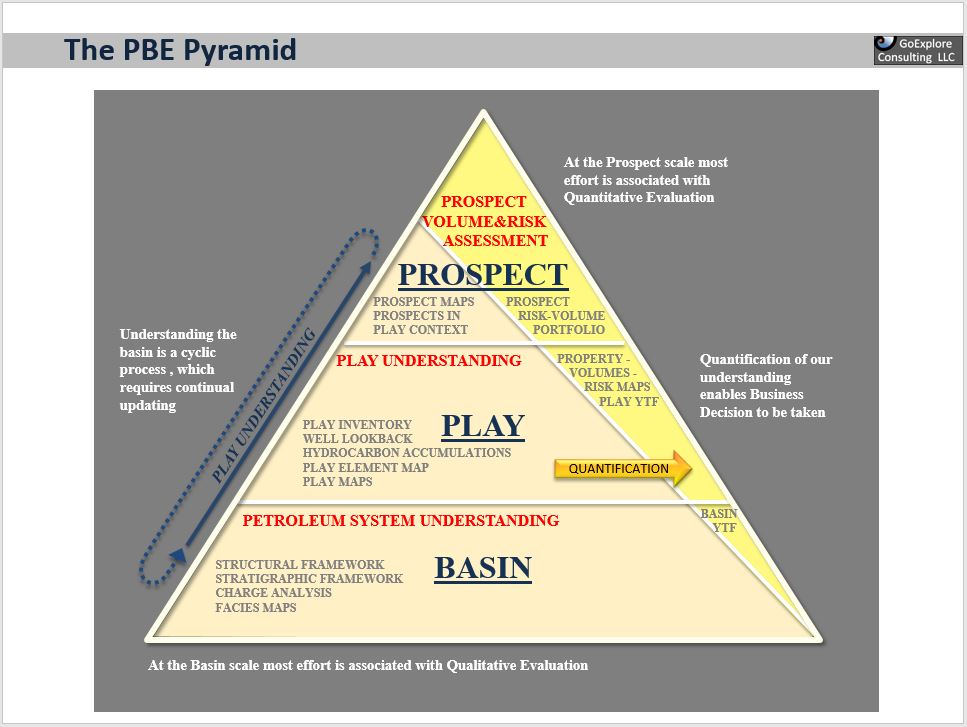Prospect Evaluation in the Play-Context
Course length: 3 days
Location: this course is given as an in-house class at your preferred location
Target Students
This course is aimed at young and experienced technical professionals with 2-25 year of oil industry experience who are either currently working as explorers or intend to work for an exploration division. Students should have a basic knowledge of basin evolution and petroleum systems.
Course Overview
Best practice exploration demands that geoscientists apply a holistic evaluation approach and optimal success can only be achieved via a complete understanding of the workings of a basin and it’s petroleum systems. This requires the integration of all relevant geologic elements in order to fully describe the exploration opportunity all the way from basin scale to prospect scale. This “back-to-basics” approach of multi scale integration is commonly referred to as Play Based Exploration and is the subject of this course.
The PBE Pyramid
The class is largely exercise based and seeks to promote the use of fundamental geological skills. The exercises use a set of regional seismic lines and well logs to evaluate a sedimentary basin. Students will use their basic skills to describe the evolution of the basin, identify mega sequences, predict sedimentary fill and construct a Wheeler diagram to characterize the basin. Fundamental charge modeling principles are used to predict oil and gas windows. A play identification exercise requires students to consider the interaction the different play elements. The following exercises use the seismic and well data to generate maps describing the spatial variation of the elements contributing to a specific petroleum system. These play element maps are then combined to generate a composite play map that describes the spatial control on the location and size of hydrocarbon accumulations.
After completing a play map, the class moves on to the quantification of the basin’s hydrocarbon potential. Students learn the basic concepts of prospect risking and probabilistic volume estimation. A prospect from the previously evaluated play is used in exercises designed to reinforce the concept of assigning risk and volumes in a play context.
Building Prospects from the Bottom Up. The course follows the same workflow.
Software
During the course we will make use of the Free GoExplore Software Suite, and Freeware Suites, which you can Download Here.
Learning Outcomes
By the end of the class students will have a good understanding of how to identify critical play elements on seismic and well data and transfer these to maps. Students will also learn how to use these play maps to identify exploration sweet spots and incorporate their play understanding into the quantification of the risk and volume of potential prospects.
Teachers
The class is taught by Steven Bloemendaal, Larry Garmezy and Calum Macdonald, who have together more than 90 years of experience in Hydrocarbon Exploration in Shell. During the last 10 years they ran the internal Shell Classes on Play Based Exploration and Risk & Volumes, which for 10 consecutive years was evaluated as the best Exploration Class in Shell.
Course Schedule
Day 1:
Basin evolution exercise and mega sequence identification
Basin fill exercise and Wheeler diagram generation
Day 2:
Basics of petroleum systems
Play element mapping: Charge
Play element mapping: Structure
Play Identification
Play element mapping: Reservoir
Play element mapping: Seal
Day 3:
Dry well analysis
Composite play map generation
Risk and uncertainty analysis
Common risk segment mapping
Prospect risking
Exploration volume estimation
Prospect evaluation

